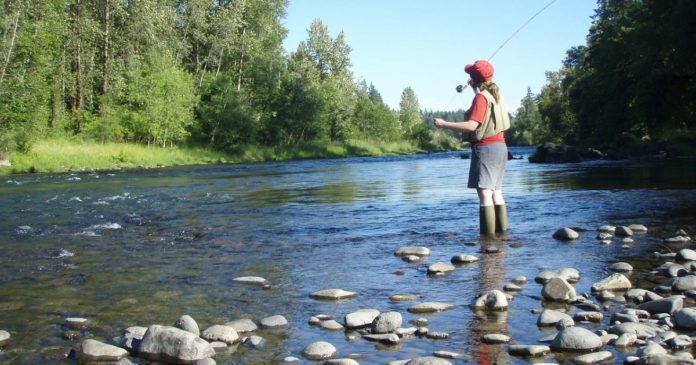Where there’s stressed fish, there’s stressed fishing guides. As Montana and much of the west feel the effects of persistent drought, those with a line in the future of the state’s fisheries are navigating high temperatures, low flow and closures across the state.
Just south of Dillon, anglers flock to the Beaverhead River below Clark Canyon Reservoir. The dam-controlled flows run cool and clean — something trout and anglers can’t resist.
This is one of the few places cold enough to fish without restrictions in Southwest Montana as hot, dry weather forces state closures across the region.
The restrictions, called “hoot owl closures,” are intended to give fish a break from anglers during the heat of the day, when they’re more susceptible to disease and death from rising temperatures. “Hoot owls” prohibit fishing from 2 p.m. to midnight. Fly fishing guide Kellen Binger spends the majority of his season taking clients out in this part of the state. He understands the need to close rivers to protect fish when it gets this hot, but it complicates how he makes a living.
“It’s a good thing they need to do that, right, but from a guide’s standpoint, that’s how we make our money,” Binger says.
He loves what he does, but finds himself grappling with questions about his future career, and the future of these waters.
“I’m gonna get out of the industry if it goes the way it’s going. It’s scary, right, you know, it’s not for sure, nothing’s for sure.”
Montana put in place its first fishing restrictions on June 17, a date state wildlife officials said was not unprecedented, but unseasonably early. From the Beaverhead to the Yellowstone, water conditions have led state wildlife officials to place restrictions and complete closures on more than a dozen rivers and creeks. Yellowstone National Park also implemented park-wide restrictions on fishing for the first time in over a decade.
Hoot owl closures have been the state’s most direct action to regulate hot and low rivers and streams since 2008.
Eileen Ryce is the fisheries administrator with Montana Fish, Wildlife and Parks.
“I don’t know if there is anything such as a perfect rule,” Ryce says.
She says the current model for protecting cold water fisheries will need to be reevaluated after this summer, as conservationists and guides and outfitters alike call for reform and clarity.
“It’s hard to change a rule right in the middle of the season when we’re in the middle of implementing it, but we are going to have that conversation this fall.”
Last month, a cohort of conservation groups, guides and outfitters signed a letter to Gov. Greg Gianforte asking him to create a task force dedicated to protecting cold water fisheries in Montana.
Guy Alsentzer is the executive director of the Bozeman-based nonprofit Upper Missouri River Waterkeeper, and he stressed the urgency for action during a Facebook Live event in July.
“We need to stop treating this as a deviation and just a minor drought, and we need to talk about it being this is the new way of doing business in the West,” Alsentzer says.
In their letter calling for the state to develop a new plan for cold-water fisheries, Upper Missouri Waterkeeper and others wrote that if water quality continues to decline in Montana rivers, because of factors like the declining yearly snowpack, the changes would tank the state’s $7 billion outdoor economy.
Brooke Stroyke, a spokesperson for the governor’s office, told MTPR in a statement that the governor “shares Montanans’ concerns about this unprecedented drought.” The statement did not directly say if Gianforte would be open to creating the task force. Others are calling on Montana to reevaluate its relationship with its waterways.
Clayton Elliott is the Conservation and Government Affairs Director with Montana Trout Unlimited.
Elliott wasn’t a part of the group that signed the letter asking the Gianforte administration to create a cold water fisheries task force, but he says conservationists, guides, outfitters, farmers and ranchers need to come to the table help to balance the needs of the recreation industry and the health of fish.
“There’s some validity to it, but things are being loved to death. Our streams and rivers are getting to the point where they’re being loved to death,” Elliott says.
During the Montana Fish and Wildlife Commission’s meeting August 20, commissioners plan to discuss future fishing regulations and specifically southwest Montana brown trout regulations.
Credit: Source link































